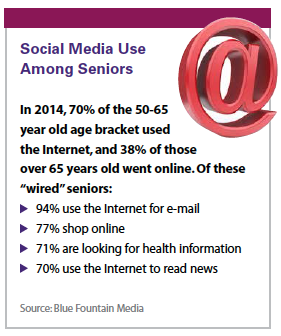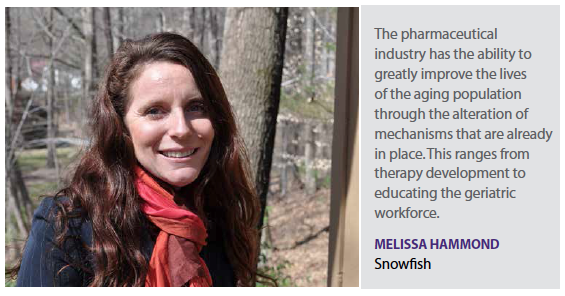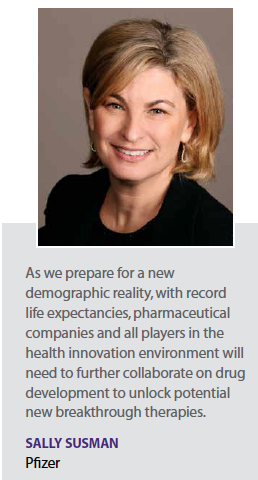 With more than 10,000 people a day turning 65 in the United States, the industry is preparing to meet the demand of this older population. Two avenues include exploring regenerative medicine, and tailoring digital strategies to this online-savvy demographic.
With more than 10,000 people a day turning 65 in the United States, the industry is preparing to meet the demand of this older population. Two avenues include exploring regenerative medicine, and tailoring digital strategies to this online-savvy demographic.
To meet the upcoming demand from the nearly 2 billion people over 60, pharma and biotech companies are investing in regenerative medicine — most often through collaborations and partnerships. According to a report by the Alliance for Regenerative Medicine, there have been several recent significant collaborations this year, including Bristol-Myers Squibb paying $50 million for exclusive rights to uniQure’s gene therapy platform, and Aduro making a $750 million immuno-oncology deal with Novartis. Bluebird bio has entered into deals with fellow biotech companies Five Prime Therapeutics, converting Five Prime’s human antibodies to CAR-T cell products, and Kite Pharma, combining TCR cell therapy candidates with Bluebird bio’s expertise in gene editing. Also, Astellas US and Anokion SA entered into a partnership to create a new company, Kanyos Bio, to work on antigen-specific immune tolerance in several indications.
Juno Therapeutics has been particularly active this year in the M&A and partnership space. It acquired Stage Cell Therapeutics in May and X-BODY in June. The company announced a joint clinical program with MedImmune, the biologics arm of AstraZeneca, examining the potential of combining CAR-T cell candidates with an early stage PD-L1 inhibitor. Juno entered a partnership with Editas Medicine, paying Editas $25 million upfront and more for support and commercialization over time for use of its genome editing technologies to uncover therapies for a wider range of cancers. Most recently, Juno announced a sweeping 10-year global collaboration with Celgene focused on transformational immunotherapies for cancer and autoimmune diseases.
 According to the Alliance for Regenerative Medicine report, historically, the healthcare industry could only hope to manage various conditions and/or symptoms of disease, but today, especially in cell and gene therapies, it is focused on harnessing the immune system and targeting patients’ cells with the aspiration to effect cures.
According to the Alliance for Regenerative Medicine report, historically, the healthcare industry could only hope to manage various conditions and/or symptoms of disease, but today, especially in cell and gene therapies, it is focused on harnessing the immune system and targeting patients’ cells with the aspiration to effect cures.
“As we continue to investigate the next stages of advanced therapies, we are buoyed and spurred on by anticipated milestones such as the clinical durability of treatments and robust response rates, especially, for example, in relapsed/refractory patients who face situations where they literally have had no medically viable alternatives," says Michael Perry, DVM, Ph.D., chief scientific officer, cell and gene therapy unit, Novartis Pharmaceuticals Corporation, in the report. “These advances represent potential major paradigm shifts in treatments for patients."
“As we prepare for a new demographic reality, with record life expectancies, pharmaceutical companies and all players in the health innovation environment will need to further collaborate on drug development to unlock new potential, breakthrough therapies," says Sally Susman, executive VP, corporate affairs, at Pfizer. “Through these open and flexible collaborations, we’re well-positioned for the most productive scientific exchange and alternative sources of funding to develop potential new therapies that patients demand and deserve."
The treatment for degenerative diseases such as Alzheimer’s disease, Parkinson’s disease, heart disease, and osteoarthritis is a prominent unmet need that needs to be addressed, according to Melissa Hammond, managing director, Snowfish. Currently, there are no cures or even ways to slow the progression of these diseases.
 “Ask any healthcare provider or exhausted family member caring for a patient with dementia and with great zeal, they will tell you that effective management of such degenerative diseases has long been an unmet need," Ms. Hammond says. “Given the changing demographics, finding a solution is even more critical."
“Ask any healthcare provider or exhausted family member caring for a patient with dementia and with great zeal, they will tell you that effective management of such degenerative diseases has long been an unmet need," Ms. Hammond says. “Given the changing demographics, finding a solution is even more critical."
The results of further developing regenerative medicine may realize ways to not only stabilize disease but also eventually improve symptoms. As regenerative therapy will likely provide a cure, patients are more apt to start and remain on the therapy long-term. This offers evidence to the concept that long-term adherence to these therapies will be optimal.
“Large pharma companies are wisely investing in this technology, as the target patient population will only grow over time and along with it the demand for such therapies," Ms. Hammond says.
The large number of baby boomers is substantive, but another factor is that as a generation, they aren’t that healthy.
As reported in a 2013 JAMA article — titled The Status of Baby Boomers’ Health in the United States: The Healthiest Generation? — boomers are living longer, but they experience more chronic diseases such as hypertension, diabetes, and hypercholesterolemia. Additionally, they tended to have higher levels of disability.
Seniors on Social Media
Think seniors aren’t on social media? Think again, say our experts. These are not your traditional grandparents. They are active on Facebook, Twitter, and Pinterest. According to an All Assisted Living Homes 2010 report, 11% of Facebook users are seniors. These 14.8 million users represent a 1,448% yearly growth in this demographic. Seniors are learning how to use online tools such as Facebook, and one in five of these users will log on for an hour any given day.
The rate of senior Americans adopting social media is steadily increasing. For the first time, more than half of all online adults 65 and older (56%) use social media, Facebook in particular, according to Pew Research Center’s Social Media Update for 2014. This represents 31% of all seniors in the United States.
This is one of the reasons Pfizer initiated the Get Old campaign, to ignite dialogue among seniors on Facebook and Twitter to challenge stereotypes and perceptions around aging.
 “In 15 years, 20% of Americans will be 65 or older, making discussions on aging increasingly more relevant," Ms. Susman says. “With more than half of baby boomers active on social media, we’re seeing more conversations ranging from Alzheimer’s to menopause taking place online."
“In 15 years, 20% of Americans will be 65 or older, making discussions on aging increasingly more relevant," Ms. Susman says. “With more than half of baby boomers active on social media, we’re seeing more conversations ranging from Alzheimer’s to menopause taking place online."
According to a Forbes report, brands might want to have separate social media accounts for this specific demographic so they can cater their content more to the wired senior needs. For example, research is showing that this demographic prefers images and stories, rather than promoting services. But besides type of content, the same principles apply in creating a social media marketing plan: have a focused target, engage with users, listen carefully, and commit to frequent use.
“In the effort to become more patient centric and add further value to the therapies it markets, industry has been providing a slew of technology offerings," Ms. Hammond says. “They include websites and mobile apps, which help individuals do everything from mapping certain disease parameters — glucose, blood pressure, and cholesterol — to therapy adherence, and lifestyle coaching."
There is also evidence of industry going beyond these efforts and exploring collaborations with other technology manufacturers to offer an overall solution for preventing and managing chronic diseases.
Pfizer recently published a report, Preventive Care and Healthy Aging, commissioned through the Economist Business Intelligence Unit, which highlighted the significance of healthy aging and the value of preventative care with respect to reducing the cost of care globally.
The report noted that the industry tends to take a very reactive approach to healthcare delivery, which is totally counterintuitive to the care of older individuals.
The life-science industry will need to prepare critically and think creatively to take advantage of the various opportunities related to the aging population. (PV)


















